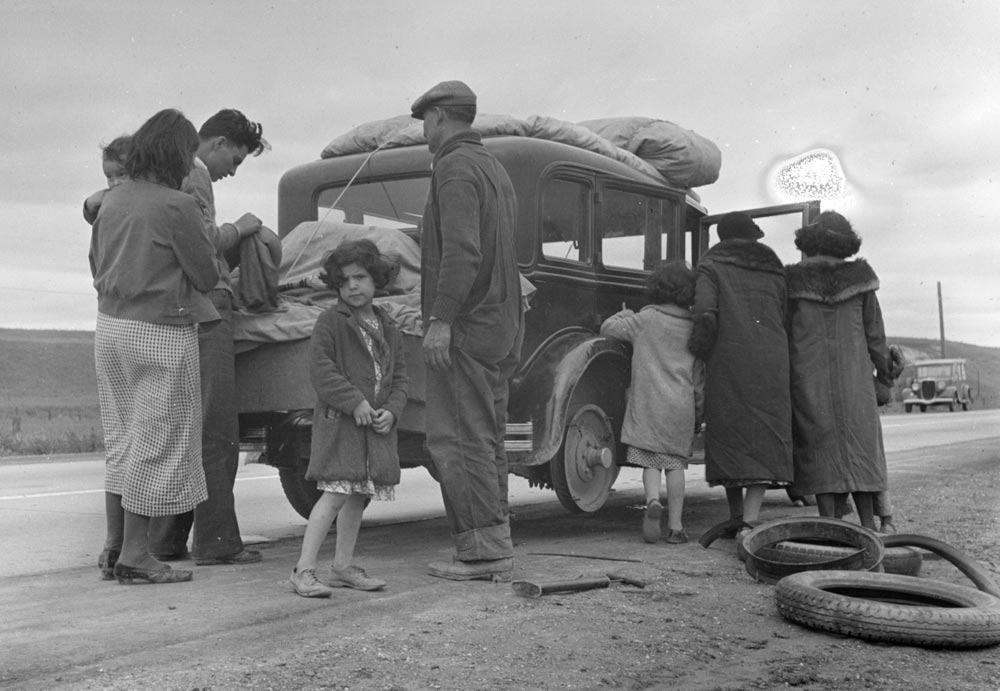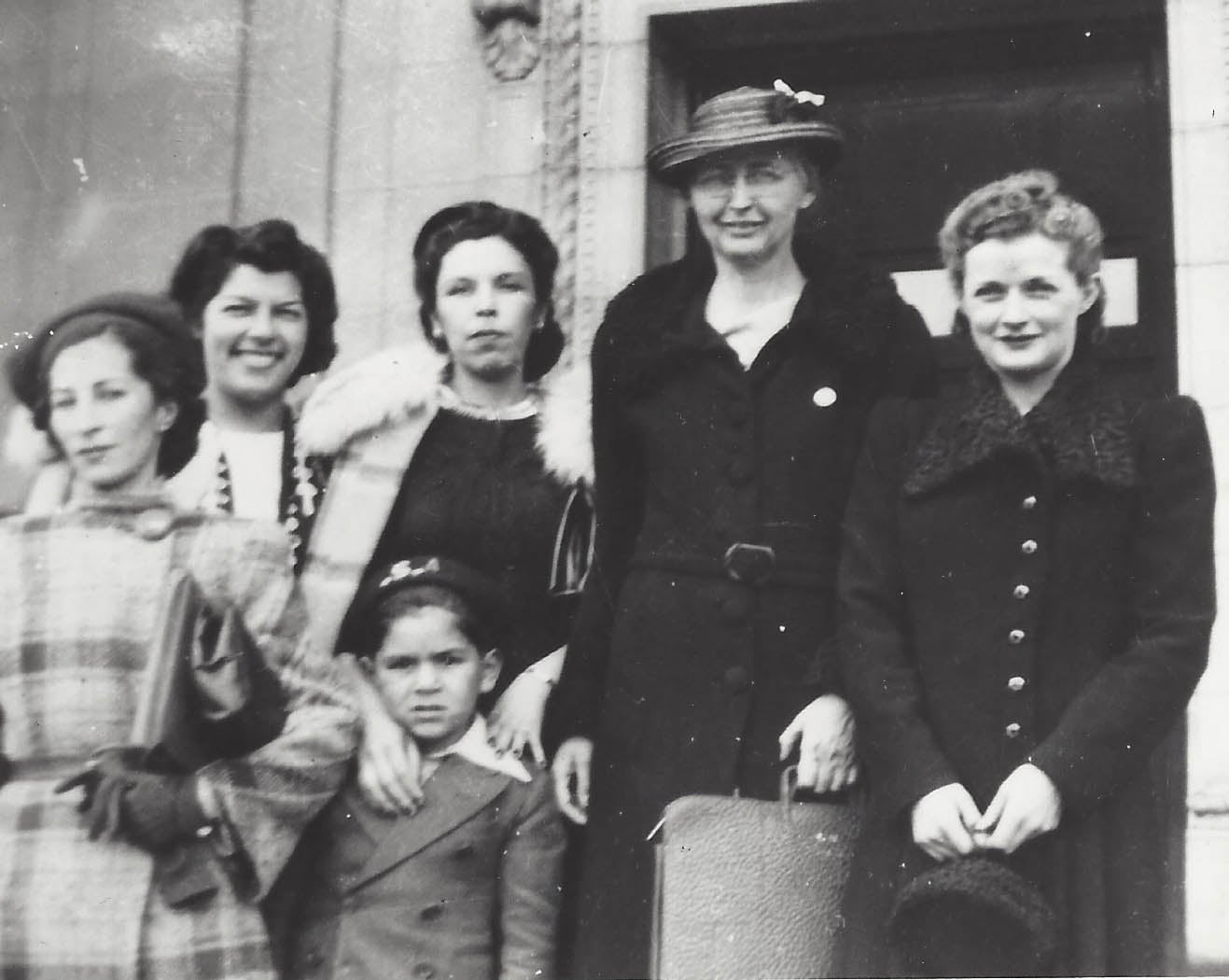Risk Takers and History Makers: Mexican Women of the World War II Generation
by Vicki L. Ruiz
Escaping poverty and revolution and lured by prospective employment in agriculture, mining, transportation, and the building trades, more than one million Mexicans migrated to the United States between 1910 and 1930, an estimated one-tenth to one-eighth of Mexico’s population. They settled into existing southwestern barrios and created new communities primarily in the Southwest and Midwest. Family migration was common. For Pasquala Esparza, journeying to El Paso with her nine-year-old daughter Jesusita and infant Raquel, the United States represented a safe haven from domestic abuse. Decades later Jesusita reflected: “My mother got married again and things did not work. I guess they did not work because I was mistreated, too, you know.” [1]
 A sense of refuge, however, eluded many Mexican American children and their parents. For women who came of age during the 1930s and 1940s, citizenship mattered little. During the early 1930s, one-third of the ethnic Mexican population in the United States (more than one million people) were either deported or repatriated to Mexico even though an estimated 60 percent were native US citizens, mostly children. Viewed as foreign usurpers of American jobs and as unworthy burdens on charity rolls, Mexicans were the only immigrants targeted for removal. They were either summarily deported by immigration agencies or persuaded to depart voluntarily by duplicitous social workers who greatly exaggerated the opportunities awaiting them south of the border. Emilia Castañeda and her family were forced to leave with little warning, even though her father, a recent widower, was a US legal resident and Emilia a citizen by birth. From the age of nine to nineteen, she lived in Mexico under dire circumstances. In her words: “We lived under a tree and a tent for awhile. We had no running water and we had to hang our food on ropes so the rats wouldn’t get it.” Now over ninety years old, Castañeda gives inspiring talks to schoolchildren about her experiences as she advocates for the inclusion of Depression-era deportations as part of the California K−12 History-Social Science Framework. [2]
A sense of refuge, however, eluded many Mexican American children and their parents. For women who came of age during the 1930s and 1940s, citizenship mattered little. During the early 1930s, one-third of the ethnic Mexican population in the United States (more than one million people) were either deported or repatriated to Mexico even though an estimated 60 percent were native US citizens, mostly children. Viewed as foreign usurpers of American jobs and as unworthy burdens on charity rolls, Mexicans were the only immigrants targeted for removal. They were either summarily deported by immigration agencies or persuaded to depart voluntarily by duplicitous social workers who greatly exaggerated the opportunities awaiting them south of the border. Emilia Castañeda and her family were forced to leave with little warning, even though her father, a recent widower, was a US legal resident and Emilia a citizen by birth. From the age of nine to nineteen, she lived in Mexico under dire circumstances. In her words: “We lived under a tree and a tent for awhile. We had no running water and we had to hang our food on ropes so the rats wouldn’t get it.” Now over ninety years old, Castañeda gives inspiring talks to schoolchildren about her experiences as she advocates for the inclusion of Depression-era deportations as part of the California K−12 History-Social Science Framework. [2]
By 1935 the removal campaigns diminished, but poverty, segregation, and economic segmentation remained. Typically, after the eighth grade, city girls went to work in canneries, packinghouses, garment factories, and in the service industry. According to one University of California study, children provided over one-third of the total household income. A generation gap emerged between parents and adolescents, especially girls. Parents strictly supervised their children, insisting that daughters have a chaperone whenever they ventured out to a movie, dance, or even church events. “Ditching the dueña” was a common refrain among women of this era. Carmen Bernal Escobar could invite her boyfriends to her home but only under the supervision of her mother or brother.
Young women’s stance for independence extended beyond the home. Chafing against hive-inducing peach fuzz, slippery floors, supervisor favoritism, and wage theft (to name a few of their grievances), Mexican and Jewish “cannery girls” placed their faith in organized labor.  As a young married mother, Escobar emerged as a skillful grassroots leader of a union drive, taking charge of the secondary boycott committee during the successful California Sanitary Canning Company Strike of 1939, a campaign not only for better wages and conditions, but also to stop workplace harassment. Carmen’s union—the United Cannery, Agricultural, and Allied Workers of America (UCAPAWA-CIO)—would become a highly successful national union. In southern California, Carmen and her colleagues negotiated contracts that provided benefits that few industrial unions could match—free legal advice and a hospitalization plan. A fierce loyalty developed as the result of rank-and-file leadership. Four decades after the strike, Carmen Bernal Escobar declared, “UCAPAWA was the greatest thing that ever happened to the workers at Cal San. It changed everything and everybody.” [3]
As a young married mother, Escobar emerged as a skillful grassroots leader of a union drive, taking charge of the secondary boycott committee during the successful California Sanitary Canning Company Strike of 1939, a campaign not only for better wages and conditions, but also to stop workplace harassment. Carmen’s union—the United Cannery, Agricultural, and Allied Workers of America (UCAPAWA-CIO)—would become a highly successful national union. In southern California, Carmen and her colleagues negotiated contracts that provided benefits that few industrial unions could match—free legal advice and a hospitalization plan. A fierce loyalty developed as the result of rank-and-file leadership. Four decades after the strike, Carmen Bernal Escobar declared, “UCAPAWA was the greatest thing that ever happened to the workers at Cal San. It changed everything and everybody.” [3]
During World War II, Mexican American women flocked to defense industries as Rosie the Riveters, propelled by patriotism and earning potential. With a sense of pride, Alicia Mendeola Shelit remembered, “All I knew was to just bring the money in to feed my kids like a man.” Historian Elizabeth Escobedo beautifully chronicles how women made meaning in their own lives as the war opened up for them unprecedented opportunities in terms of defense work and popular culture. Chaperonage became replaced by “going out with the girls” to ballrooms, parties, amusement parks, and other sites of commercialized leisure. Some young women were hard-working Rosies by day but daring pachucas by night, while others volunteered as hostesses (Señoritas USOs) at segregated hospitality centers for Mexican American servicemen. There emerged a freer, more integrated social environment among European American, Mexican, and African American youth in wartime Los Angeles on both the shop floor and dance floor. [4]
The courtship of Andrea Pérez and Sylvester Davis had all the makings of a 1940s Hollywood movie—pretty Rosie the Riveter strikes up a friendship with her dashing co-worker; he leaves to fight for their country; and upon his return, they fall in love and plan to marry. But before the credits could roll, the couple would have to challenge state law. Pérez was the daughter of Mexican immigrants and Davis was African American. Fully aware that California’s anti-miscegenation statute prohibited their union, they hired civil rights attorney Dan Marshall, a leader in the liberal Los Angeles Catholic Interracial Council. After a Los Angeles County clerk denied the couple a marriage license, Andrea Pérez filed suit. [5]
In 1948 the California Supreme Court ruled in Pérez’s favor, becoming the first state supreme court to strike down an anti-miscegenation law. As Dara Orenstein brilliantly revealed, this decision hinged, in part, on mestizaje. She argued that the court deemed the statute “too vague and uncertain” given that the legislation did not take into account people of “mixed ancestry” and that government employees could not consistently determine degrees of whiteness. In addition to this line of reasoning, Judge Roger Traynor for the majority ruled that the law violated the equal protection clause of the Fourteenth Amendment. At the time of the decision, Earl Warren was governor of California and, nineteen years later, he would preside as chief justice in Loving v. Virginia, the US Supreme Court case that struck down all remaining state anti-miscegenation laws. [6]
Pérez v. Sharp unfolded with little fanfare but signified a greater fluidity of social relations in California, especially among youth. The couple married in 1949 and a year later another interracial California Catholic couple followed suit: Rosina Rodríguez and Leon Watson. Only nineteen and twenty, they met as progressive activists in the local chapter of the Civil Rights Congress. In Rosina’s words: “There were blacks, whites, Hispanics, and other nationalities all united for the same causes . . . They organized pot luck dinners and dances at one another’s homes . . . We were in our own world.” [7] Both couples scripted their own happily ever afters and in the process made history.
Mexican American women of the World War II generation claimed public space in consequential ways. Lovingly situating his mother Carmen within her historical moment, historian Edward Escobar referred to her life as “emblematic of twentieth-century Mexican immigrant women’s experiences in the United States.” He wrote, “She combined traditional Mexican and Catholic values with American working-class progressivism to fashion a life that included marriage, motherhood, and labor activism.” [8] Though I have said it many times in print and on the podium, the phrase bears repeating: Latina history is American history.
[1] Vicki L. Ruiz, From Out of the Shadows: Mexican Women in Twentieth-Century America (New York: Oxford University Press, 1998, 2009): 3−32; Interview with Jesusita Torres, January 8, 1993, conducted by the author.
[2] The most comprehensive survey of the Mexican deportations and repatriations during this period is Francisco Balderrama and Raymond Rodríguez, Decade of Betrayal: Mexican Repatriation in the 1930s (Albuquerque: University of New Mexico Press, 1995). Leslie Hiatt, “How My 4th-Grade Class Passed a Law on Teaching Mexican ‘Repatriation,’” Rethinking Schools 32: 4 (Summer 2018), https://www.rethinkingschools.org/articles/how-my-4th-grade-class-passed-a-law-on-teaching-mexican-repatriation (accessed January 4, 2019).
[3] Ruiz, Shadows, 63; Vicki L. Ruiz, Cannery Women, Cannery Lives: Mexican Women, Unionization, and the California Food Processing Industry, 1930−1950 (Albuquerque: University of New Mexico Press, 1987); Interview with Carmen Bernal Escobar, February 11, 1979, conducted by the author.
[5] Dara Orenstein, “Void for Vagueness: Mexicans and the Collapse of Miscegenation Law in California,” Pacific Historical Review, 74: 3 (August 2005): 367−407; Alex Lubin, “What’s Love Got to Do With It?: The Politics of Race and Marriage in the California Supreme Court’s 1949 Perez v. Sharp Decision,” OAH Magazine of History , 18:4 (July 2004): 31−37; Peggy Pascoe, What Comes Naturally: Miscegenation Law and the Making of Race in America (New York: Oxford University Press, 2009): 207−223.
[6] Orenstein, “Void for Vagueness,” 370−371; Lubin, “What’s Love Got to Do With It?” 31−37. Quotes are from Orenstein, “Void for Vagueness,” 371, 370, respectively.
[7] Sharon Abercrombie, “Couple Who Broke Color Barrier Wed 60 Years Ago,” The Catholic Voice, 48:5 (March 8, 2010), https://www.catholicvoiceoakland.org/2010/03-08/inthisissue1.htm (accessed January 5, 2019).
[8] Edward Escobar, “Escobar, Carmen Bernal,” Latinas in the United States: A Historical Encyclopedia, 3 vols., ed. Vicki L. Ruiz and Virginia Sánchez Korrol (Bloomington: University of Indiana Press, 2006), 1: 237−238.
Vicki L. Ruiz is Distinguished Professor Emerita of History and Chicano/Latino Studies at the University of California, Irvine. An award-winning scholar and educator, she is the author of Cannery Women, Cannery Lives (University of New Mexico Press, 1987) and From Out of the Shadows: Mexican Women in Twentieth-Century America (Oxford University Press, 1998). A fellow of the American Academy of Arts and Sciences, she is past president of the American Historical Association and the Organization of American Historians. In 2015 she was awarded the National Humanities Medal by President Barack Obama.





































































